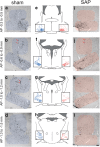Diverse Roads to Relapse: A Discriminative Cue Signaling Cocaine Availability Is More Effective in Renewing Cocaine Seeking in Goal Trackers Than Sign Trackers and Depends on Basal Forebrain Cholinergic Activity
- PMID: 28659281
- PMCID: PMC5546399
- DOI: 10.1523/JNEUROSCI.0990-17.2017
Diverse Roads to Relapse: A Discriminative Cue Signaling Cocaine Availability Is More Effective in Renewing Cocaine Seeking in Goal Trackers Than Sign Trackers and Depends on Basal Forebrain Cholinergic Activity
Abstract
Stimuli associated with taking drugs are notorious instigators of relapse. There is, however, considerable variation in the motivational properties of such stimuli, both as a function of the individual and the nature of the stimulus. The behavior of some individuals (sign trackers, STs) is especially influenced by cues paired with reward delivery, perhaps because they are prone to process information via dopamine-dependent, cue-driven, incentive salience systems. Other individuals (goal trackers, GTs) are better able to incorporate higher-order contextual information, perhaps because of better executive/attentional control over behavior, which requires frontal cortical cholinergic activity. We hypothesized, therefore, that a cue that "sets the occasion" for drug taking (a discriminative stimulus, DS) would reinstate cocaine seeking more readily in GTs than STs and that this would require intact cholinergic neurotransmission. To test this, male STs and GTs were trained to self-administer cocaine using an intermittent access schedule with periods of cocaine availability and unavailability signaled by a DS+ and a DS-, respectively. Thereafter, half of the rats received an immunotoxic lesion that destroyed 40-50% of basal forebrain cholinergic neurons and later, after extinction training, were tested for the ability of noncontingent presentations of the DS+ to reinstate cocaine seeking behavior. The DS+ was much more effective in reinstating cocaine seeking in GTs than STs and this effect was abolished by cholinergic losses despite the fact that all rats continued to orient to the DS+ We conclude that vulnerability to relapse involves interactions between individual cognitive-motivational biases and the form of the drug cue encountered.SIGNIFICANCE STATEMENT The most predictable outcome of a diagnosis of addiction is a high chance for relapse. When addicts encounter cues previously associated with drug, their attention may be unduly attracted to such cues and these cues can evoke motivational states that instigate and maintain drug-seeking behavior. Although sign-tracking rats were previously demonstrated to exhibit greater relapse vulnerability to Pavlovian drug cues paired with drug delivery, here, we demonstrate that their counterparts, the goal trackers, are more vulnerable if the drug cue acts to signal drug availability and that the forebrain cholinergic system mediates such vulnerability. Given the importance of contextual cues for triggering relapse and the human cognitive-cholinergic capacity for the processing of such cues, goal trackers model essential aspects of relapse vulnerability.
Keywords: acetylcholine; addiction; basal forebrain; drug cues; relapse; sign and goal trackers.
Copyright © 2017 the authors 0270-6474/17/377198-11$15.00/0.
Conflict of interest statement
The authors declare no competing financial interests.
Figures








Similar articles
-
Unresponsive Choline Transporter as a Trait Neuromarker and a Causal Mediator of Bottom-Up Attentional Biases.J Neurosci. 2017 Mar 15;37(11):2947-2959. doi: 10.1523/JNEUROSCI.3499-16.2017. Epub 2017 Feb 13. J Neurosci. 2017. PMID: 28193693 Free PMC article.
-
Transient inactivation of the paraventricular nucleus of the thalamus enhances cue-induced reinstatement in goal-trackers, but not sign-trackers.Psychopharmacology (Berl). 2018 Apr;235(4):999-1014. doi: 10.1007/s00213-017-4816-1. Epub 2017 Dec 28. Psychopharmacology (Berl). 2018. PMID: 29285634 Free PMC article.
-
'Hot' vs. 'cold' behavioural-cognitive styles: motivational-dopaminergic vs. cognitive-cholinergic processing of a Pavlovian cocaine cue in sign- and goal-tracking rats.Eur J Neurosci. 2017 Dec;46(11):2768-2781. doi: 10.1111/ejn.13741. Epub 2017 Nov 6. Eur J Neurosci. 2017. PMID: 29044780 Free PMC article.
-
The hot 'n' cold of cue-induced drug relapse.Learn Mem. 2018 Aug 16;25(9):474-480. doi: 10.1101/lm.046995.117. Print 2018 Sep. Learn Mem. 2018. PMID: 30115769 Free PMC article. Review.
-
On the motivational properties of reward cues: Individual differences.Neuropharmacology. 2014 Jan;76 Pt B(0 0):450-9. doi: 10.1016/j.neuropharm.2013.05.040. Epub 2013 Jun 7. Neuropharmacology. 2014. PMID: 23748094 Free PMC article. Review.
Cited by
-
Sex differences in the effects of a combined behavioral and pharmacological treatment strategy for cocaine relapse prevention in an animal model of cue exposure therapy.Behav Brain Res. 2020 Oct 1;395:112839. doi: 10.1016/j.bbr.2020.112839. Epub 2020 Aug 2. Behav Brain Res. 2020. PMID: 32750464 Free PMC article.
-
Mechanisms of Shared Vulnerability to Post-traumatic Stress Disorder and Substance Use Disorders.Front Behav Neurosci. 2020 Jan 31;14:6. doi: 10.3389/fnbeh.2020.00006. eCollection 2020. Front Behav Neurosci. 2020. PMID: 32082127 Free PMC article. Review.
-
Effects of Limited and Extended Pavlovian Training on Devaluation Sensitivity of Sign- and Goal-Tracking Rats.Front Behav Neurosci. 2020 Feb 4;14:3. doi: 10.3389/fnbeh.2020.00003. eCollection 2020. Front Behav Neurosci. 2020. PMID: 32116587 Free PMC article.
-
Inhibition of a cortico-thalamic circuit attenuates cue-induced reinstatement of drug-seeking behavior in "relapse prone" male rats.Psychopharmacology (Berl). 2022 Apr;239(4):1035-1051. doi: 10.1007/s00213-021-05894-9. Epub 2021 Jun 28. Psychopharmacology (Berl). 2022. PMID: 34181035
-
Nicotine Enhances Goal-Tracking in Ethanol and Food Pavlovian Conditioned Approach Paradigms.Front Neurosci. 2021 Aug 18;15:561766. doi: 10.3389/fnins.2021.561766. eCollection 2021. Front Neurosci. 2021. PMID: 34483813 Free PMC article.
References
-
- Allain F, Roberts DC, Lévesque D, Samaha AN (2017) Intermittent intake of rapid cocaine injections promotes robust psychomotor sensitization, increased incentive motivation for the drug and mGlu2/3 receptor dysregulation. Neuropharmacology 117:227–237. 10.1016/j.neuropharm.2017.01.026 - DOI - PubMed
-
- Bindra D. (1968) Neuropsychological interpretation of the effects of drive and incentive-motivation on general activity and instrumental behavior. Psychol Rev 75:1–22. 10.1037/h0025306 - DOI
Publication types
MeSH terms
Substances
Grants and funding
LinkOut - more resources
Full Text Sources
Other Literature Sources
Medical
